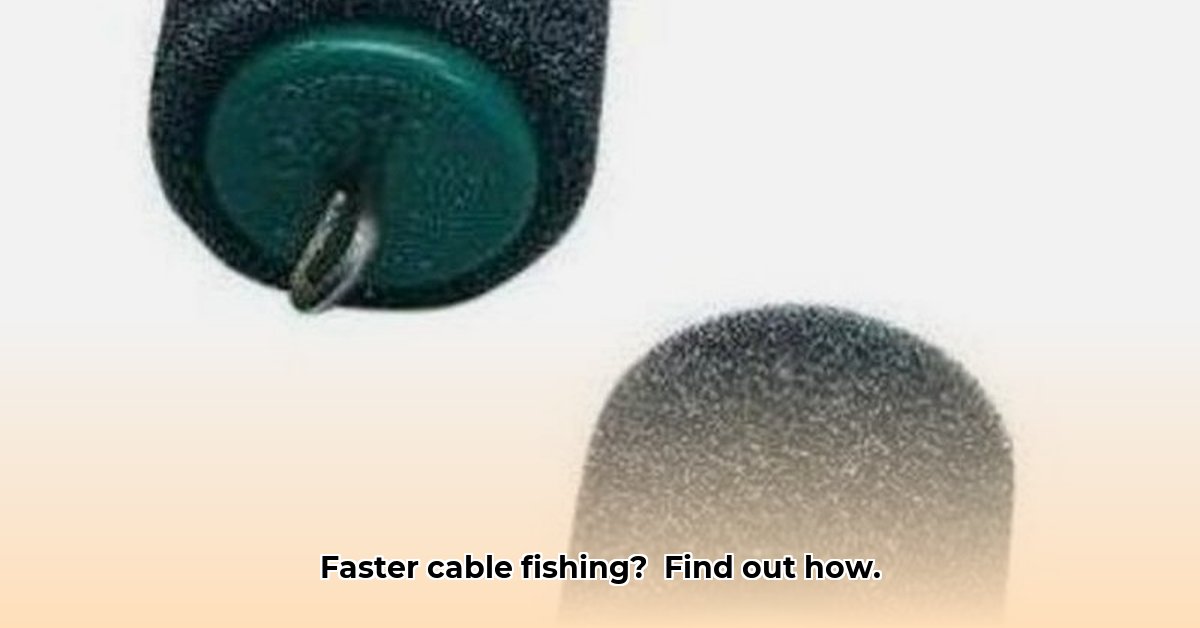
Conduit Piston: Your Secret Weapon for Faster Cable Fishing
Conduit fishing pistons are essential tools for electricians and contractors, significantly speeding up cable installation. These tools essentially act as high-powered plungers, designed to minimize friction and smoothly push cables through conduits (pipes). This translates to time saved and reduced frustration on the job site.
Picking the Right Size: It's Crucial!
Selecting the correct size conduit piston is paramount. Using an improperly sized piston can result in cable damage or a completely ineffective workflow. Here's how to choose correctly:
- Precise Measurement: Carefully measure the inside diameter of your conduit. Accuracy is vital.
- Manufacturer Specifications: Consult the manufacturer's specifications to match the piston to the conduit size.
- Cable Diameter Consideration: The piston must be large enough to comfortably accommodate your cable, but not so large as to create excessive friction or the risk of damage. Finding this sweet spot ensures maximum speed and minimizes potential problems.
What Makes a Good Conduit Piston? The Materials Matter!
A high-quality conduit piston is built to last. Key features include:
- Durable Steel Center Rod: A robust steel center rod resists bending, which ensures smooth operation and long-term usability.
- Friction-Reducing Foam Body: The flexible foam body minimizes friction, protects the conduit from scratches, and contributes to the smooth passage of cables.
- Color-Coded Identification: Color-coded end discs simplify identification and ordering, making inventory management easier.
Getting the Most Out of Your Conduit Piston
Maximize your conduit piston's effectiveness by following these best practices:
- Lubrication: Applying a silicone-based lubricant to the piston surface dramatically reduces friction.
- Straight Insertion: Insert the piston straight into the conduit to prevent jamming.
- Consistent Pressure: Apply steady, consistent pressure—avoid jerky movements. This prevents damage and optimizes speed.
- Regular Inspection: Periodically inspect the conduit, cable, and piston for any signs of wear or damage. Early detection prevents larger problems.
When Things Go Wrong: Troubleshooting Tips
Even with the best tools, occasional issues may arise. Here are solutions for common problems:
- Stuck Piston: If the piston becomes stuck, try applying lubricant and gently rocking it back and forth. If this fails, carefully remove the cable.
- Cable Damage: Inspect the cable for kinks or damage before beginning work. Damaged cable will only exacerbate problems.
- Obstructions in Conduit: Check for debris or sharp bends obstructing the conduit.
If problems persist, consult the manufacturer's instructions or seek professional assistance.
The Future of Conduit Pistons: Smart Technology on the Horizon
Conduit piston technology is constantly evolving. Future innovations may include:
- Integrated Sensors: Sensors could monitor pressure, temperature, and location within the conduit, improving efficiency and reducing downtime.
- Advanced Materials: New materials may further increase durability and reduce friction.
Comparing Greenlee Conduit Fishing Pistons to Competitors’ Performance Metrics
The conduit fishing piston market offers many choices, catering to various conduit sizes and applications. Greenlee pistons are renowned for their quality and "Made in the USA" manufacturing. However, comprehensive comparative data on Greenlee versus competitors is currently limited. This lack of readily accessible, independently verified performance data hinders informed purchasing decisions.
Understanding Conduit Fishing Pistons
Effective conduit fishing requires reliable tools. Conduit fishing pistons, whether air-powered or vacuum-based, are crucial for efficient cable installation. Choosing the right one requires careful consideration of several factors.
The Greenlee Advantage: A Closer Look
Greenlee's reputation precedes it. Their pistons are frequently praised for durability and consistent performance. The "Made in the USA" aspect appeals to users prioritizing quality and supply chain transparency. Yet, a direct, data-driven comparison with competitors remains elusive.
The Challenge: Lack of Comparative Data
Finding objective, comparable performance data between Greenlee and competitors is difficult. Manufacturer websites usually highlight features without offering side-by-side comparisons or independent testing results. This information gap makes informed purchasing decisions challenging.
What We Do Know (and What We Need)
Several key factors influence piston performance:
- Material Strength: Higher-grade steel in the piston's core rod directly impacts durability and longevity.
- Seal Integrity: The foam body's design and material influence sealing and resistance to wear. Precise material specifications are essential for direct comparison.
- Pressure Ratings: Maximum operating pressure affects pushing power; higher ratings (within safe limits) increase efficiency.
- Line Attachment: The end loop design must securely hold the line to prevent slippage.
To accurately compare Greenlee with other brands, standardized testing protocols are necessary. This would include performance measurements across various conduit types (PVC, steel, etc.) under different conditions, quantifying metrics such as line speed, lifespan before failure, wear resistance, and more.
How to Choose the Right Piston: A Practical Guide
Selecting the right conduit piston involves:
- Needs Assessment: Determine conduit sizes, materials, and frequency of use.
- Review Analysis: Examine user reviews for insights into durability and ease of use.
- Specification Scrutiny: Carefully review pressure ratings, material composition, and dimensions.
- Cost-Benefit Analysis: Price must reflect quality and performance; cheaper options might prove less durable.
- Compatibility: Ensure the piston is compatible with your existing system.
Moving Forward: The Need for Transparency
Greater transparency in the conduit fishing piston market is needed. Detailed specifications and independent performance benchmarks would benefit contractors. Manufacturers should invest in independent testing to validate their claims, building greater trust and confidence within the industry.
⭐⭐⭐⭐☆ (4.8)
Download via Link 1
Download via Link 2
Last updated: Sunday, June 08, 2025